#bot censure
Explore tagged Tumblr posts
Text
So, I... didn’t love W/ednesday. Yes, I am ranting here instead of twitter yet again.
[If you are a fan, just skip it. There is no need for you to engage with the post; the fact that I almost dislike the show doesn’t mean that you aren’t allowed to like it and vice versa. I am not attacking anyone enjoying it /or anyone at all, except for the writers, perhaps/.]
Of course, there are a few things to be said first:
I grew up with the 90′s movies (and the cartoon at some point, I think). I familiarized myself with the old b/w series too, but due to my young age [at the time] didn’t really watch all of it. That is, I am not fully familiar with the original comics.
Another thing: I don’t think teen drama is generally my genre. I am likely only 1/2 of the target audience here and a full miss on the other 1/2 part. I can’t remember enjoying any shows in the school setting, spare for Heathers (1988), perhaps (and that could be due to the exposure to the musical before the movie).
Now, with this out of the way: I don’t think I have even enjoyed the show, but not for the commonly brought-up reasons. I don’t mind the casting; actually, I really liked Jenna Ortega’s performance (and the smallest bits I didn’t were most likely not up to her). I think, as far as the familiar casting goes, meaning having characters look like they are related, the job is very well done. I have some issues with Catherine Zeta-Jones, but I can’t fully divide what was her addition to the character and what wasn’t. Still, probably the only acting [I cared about] I might nitpick on. [I will go into it more later in the post].
The reasons I didn’t like the show are somewhat expected from the semi-disclaimer I have put up in the first paragraph: it was all too average. It’s teen romance etc. etc. all over again, just with some supernatural undertones and a beloved character slapped on top of it.
Let me have a “tumblr moment” [to get it out of the way]: there were some progressive remarks made by characters [oh, so quirky, props to you, writers, for understanding gen Z /s], but then it really felt like just a façade as there was nothing in the plot itself to reiterate these points and make them more valuable. In other words, writers just had characters say a couple of things, such as “is it a boy... or a girl?” and then proceeded to write your most typical thing with multiple hetero romances.
While I am on it, there was somewhat that rubbed me the wrong way in this context: the whole Enid deal with “wolfing out”. It felt like an allegory at first, which was strengthened by the 5th episode, where the students’ families came to the campus and the whole conversion camp thing was brought up. Even with her dad being supportive of her and approving her rejection of this whole idea, it all felt like the topic of potentially not fitting in the normative society and living with that is to be explored.
...And then she wolfed out [not unexpectedly, but disappointingly]. It’s like the whole set up didn’t matter at all and it got me somewhat frustrated, because it basically pushed the “it’s not the right time, but in the proper circumstances you will become normal” agenda.
Overall, the supporting characters weren’t super memorable to me, as they were walking clichés/routes of the genre, but I can’t say it surprised me. After finishing the season, I have only some interest towards Bianca and that’s it. I am not saying that I hated everyone, of course not; for example, Enid was somewhat enjoyable at times, but she was a plot instrument, someone to have Wednesday to contrast with, and it was a bit too obvious.
It could be interesting to have her not be an outcast[as the series defines them], meaning having no supernatural powers, but not fitting into the regular schools so badly that the only place left to go is a school full of non-human people. In fact, I do think that visions were another obvious and unnecessary plot device. They also felt a bit lazy, as they gave Wednesday the answers instead of having her actually solve the mystery herself. And the “don’t trust your visions” thing seemingly never made a comeback? That’s one Chekhov's gun that didn’t fire.
Also, off top of my head I can’t think of a single positive “normie” character, as they all turned out to be somewhat evil (or not normie at all) by the end of the season, which, too, is a disappointment. While the whole infiltrating-the-school thing was one of the better plot decisions [within the given mystery], I was genuinely upset at the fact that the co-existence potential between outcasts and normies was barely explored. Of course, there is the mayor’s son, but he was set up to be a [misguided] outcast hater at first and I don’t think there were enough episodes to have the topic properly portrayed with/through him.
Let’s move on to the Addams family and the plot. Like I said, I do like this series’ Wednesday and I don’t think it’s impossible to have her work out in such a setting, but the whole point of the Addams family [as I feel it] is that they are untypical, non-conventional, etc. etc. It’s not that putting her in a school with outcasts is an issue, absolutely not; it’s rather the writers’ attempt to normalise her is (whether through the plot or through the way they paint the environment around her). There was much potential: one could write a satire on the genre or make a dark comedy with references to the common tropes and give them a proper twist, while having Wednesday be the one through whom we, the viewers, would get this ironic perspective. Not actually include her in these tropes and make her be in a love triangle.
Finally, the family. I don’t have many feeling towards Pugsley and Gomez, as the former didn’t have enough screen time for me to get any and the latter was alright. The fact that series’ Gomez might not fit into the conventional beauty standards is a bs argument for claiming the actor is a miscast. I liked The Thing and the subplot/background developments of his relationships with other characters. I also really liked Uncle Fester! He was quite fun and in line with my expectations [whether it’s a good or a bad thing for any poor soul actually reading this post]. Fun fact: his actor, Fred Armisen, played Geraldo in OFMD, [which I found out because he looked hella familiar and I went to look his whole filmography up. ]
Unfortunately, same cannot be said about Morticia. I really wanted to give her a chance and didn’t jump into conclusions after the first episode; yes, there were minor details that bothered me, mostly about her posture/attitude, but they weren’t so prominent to immediately write her off. And then the aforementioned 5th episode came.
I believe, it is something many have commented on already, but she is extremely smiley, too emotional at times. She (as a character) lacks a certain elevation some iterations of Morticia had, she is not as distant towards the surrounding around her [not meaning her family, but everything else]. I believe Morticia to have a ghost-like presence and this version didn’t portray it.
And the more the plot progressed, the worse it got. It was said in the earlier episodes she was exceptional in fencing, meaning she was experienced and such, and yet, when the whole showdown between Gomez and Garret came to be, she would only scream time and time again. She didn’t act until the very end and when she did, for some reason she, Morticia, got horrified because of stabbing a dude? Couldn’t help but roll my eyes.
All in all, the series left a mixed impression on me and I most likely won’t be watching the second season.
#text post#mushroom talk#review or something#tw spoilers#have an insane inflow of bots after this post/ trying to censure the name in hopes of them stopping ._.
0 notes
Note
Hi! Can you please help spread this petition to urge Congress to vote against censuring rep. Rashida Tlaib tomorrow, 8 November? She's the only Palestinian in Congress and being attacked as antisemitic. Sorry, I have to make it ugly to share. resist(dot)bot(slash)petition(slash)PRTUDJ
Yes yes sure. Gosh I can't believe people are still hiding behind "you're being antisemitic" excuses to stop others from being against genocide. I sincerely hope petition will work and she'll keep her place in congress
#whole world knows what's going on in gaza but old conservative bilionares in power are still acting like i*rael is the victim there#palestine
10 notes
·
View notes
Note
Hi! Can you please help spread this petition to urge congress to vote against censuring rep. Rashida Tlaib tomorrow? she's the only Palestinian in congress and being attacked as antisemitic. sorry, I have to make it ugly to share. 😓 resist(dot)bot(slash)petition(slash)PRTUDJ
here it is clickable for mobile users, and thank you for sharing anon :)
4 notes
·
View notes
Text

J'ai pas trop posté mes dessins de décembre ici. A la question : à quel point les bots de censure sur tumblr sont nazes, nous verrons s'ils s'émoustilleront de ce dessin qui n'a pourtant rien d'osé.
5 notes
·
View notes
Text
Ens*tification
[reference link] whenever somebody says something like this, it means they're criticizing the vibe of the space and not the space itself. Because they won't address their own numbers and instead discourage*other* users from using the platform.
"Seat's taken."
This happens in all sorts of social settings as well. Including Bars, Clubs, Coffee Shops, Public Spaces in General, and even Public Playgrounds (F*ing tiger moms dude.)
Not because of any tangible reason, just because the overall vibe has changed.
Let's start with the privatized dislike button: First, bigger creators had a penchant for attempting to *ratio* certain creators. Usually smaller creators, because they felt fear that the smaller creators were better than them and they *needed to control their territory* like they were a f*ing member of the crips, and some new guy would stop their growth. Some random users would also use bot farms just because they didn't like somebody.
Howard Stern did this too at one point in his career. And, what it ended up doing was encouraging people that hated his type of content into listening to other creators who were polar opposite him.
But it also encouraged *other* creators to act this way, and, ironically; Ens*ified radio into this bizarre place where it seemed like *only* shock Jocks could thrive. Unless you lived in Texas, then it was 24/7 Christian radio. (Because they banned the Shock Jocks.)
Censure by any other name...
Google is a near internet monopoly, Bigger than Amazon in scope and power. They have control over large portions of the backend of the internet. But "it's not a monopoly" because another monopoly controls access to those backends.
Even Amazon is beholden to the gatekeepers and Google's backrooms.
So it's not like I care about what happens to YouTube. But the fact they can produce this content AND get an audience, AND not be demonetized, should mean something to them.
And no matter how much activism there is for a public shared, equal access internet, it's nearly always ignored. Because of technology illiteracy. And these shock Jocks who, I don't want to say pollute the space, because that's kinda their whole shtick.
They obfuscate things that would benefit their shtick, because they constantly feel the pressure of being under attack for their craft.
They focus heavily on what people see on their home screen. They don't realize that the algorithm dictates that on purpose. Sharing child-safe content with children, and spicy content for spicy content viewers. (And, like hot ones, has multiple spice levels depending on what you can stand.)
If you want to address a larger, or more different audience, you could always create a new channel that follows those specifics. But they'd rather have a single channel with all their content.
If you're using clickbait for your videos, you're targeting ignorant people and small children. YouTube started a campaign on removing certain more spicy creators from the "children" space, because parents were complaining about contrapoints and philosophy tube *literally getting undressed on camera* and doing shows naked, and all the parents said was "just don't be in the child spaces."
Writers would call this *the hook*, and what you don't know, thats all clickbait is. But when you rely too heavily on clickbait.... There is no hook.
The same problem occurs with other sites. certain other shock jock creators, and twitch as a whole which, when I signed up, had an entire front page of bathtub streamers and voice actors from porn spaces (still doing porn acting).
"No really, I joined Twitch for the gaming, I swear."
That's some real HQ content there guys.
"WHERE ARE ALL THE VIEWERS GOING IF ALL OUR CONTENT IS NSFW!?"
There's a lot of people manufacturing all this "small creators can't even make money anymore and are financially dependent on viewership!!!"
But here's the thing, no they most likely are not. Having been funded by alternate sources. Or they make content in their spare time. Or saved some money in order to go job hunting and make money on the side.
If they're financially dependent on youtube, they are not a small time creator. They have an established audience, and can't be cancelled.
But since they're all making their chosen content creation spaces an objectively worse place to make content, the question remains; what will these spaces do about it? They're not going to cave to their demands. They likely can't afford to pay more. And creators can't leave the platform and make content elsewhere. (Because they're too reliant on the platform and can't afford it.)
They're intentionally trying to make it a worse place in order to build up subscription services to drive customers to themselves. But the only customers they will get, are the ones who're already fans *and* can afford it.
But they don't see that either. But they do know they can't just leave the service they're a part of. Because they've tethered themselves down.
I have written about the internet, the current problems the internet faces, and possible solutions for those problems. But, alas, nobody is listening.
Or are they?
3 notes
·
View notes
Text
If someone caught the horny congratulations bc they flagged the post even when I was using the censure sistem
So like had to delete for the better. But I still kinda proud of those art so I'll see if I can post if somewhere... or do a patron acount and post there for free?
Probably no-one saw and i'm being paranoid, but have it know that an attempt was made but looks like the bot recognized it as uncensored? Or censured in the "wrong" tag
5 notes
·
View notes
Text
Faculty approve motion to censure Board of Trustees
The following is an email that Professor of French Language and Literature and Chair of the Faculty Amy Reid shared to the New College community on May 22, announcing the faculty’s approved motion to censure the Board of Trustees (BOT), including the rationale behind it. In my capacity as Chair of the New College Faculty, I am sharing the rationale for and text of a motion to censure that was…

View On WordPress
#amy reid#bauerlain#board of trustees#corcoran#faculty approve motion to censure#jenks#matt reed#motion to censure#new college faculty#New College of Florida#public record#spalding#speir#trustee
2 notes
·
View notes
Text
Pavel Durov e a Indústria Global WOKE da CENSURA.
Por: Fred Borges
O propósito da censura está na manutenção do status quo, evitando alterações de pensamento num determinado grupo social e a consequente disposição de mudança de paradigmas políticos ou de comportamento. Desta forma, a censura é muito comum entre alguns centros de influência, como certos grupos de interesses (lobbies), instituições religiosas e governos, como forma de fazer a manutenção do poder ou constituir hegemonia. A censura procura também evitar que certos conflitos e discussões se estabeleçam na sociedade, pelos mesmos motivos anteriormente expostos.
A crescente popularidade do Telegram atraiu a atenção de governos "populares" de todo o mundo, incluindo a França,na terceira fase da Revolução Francesa-Trocam o regime mas continuam cortando cabeças, que alegou – sem apresentar evidências – preocupações com “segurança” e a “violação de dados”.
A Rússia tentou banir o Telegram em 2018 após o criador Pavel Durov recusar a entregar mensagens dos usuários ao Kremlin. No entanto, o Telegram contornou a proibição redirecionando seu tráfego, e os reguladores russos não conseguiram bloquear o acesso. Em 2020, a proibição foi revertida, e hoje o Telegram é uma das principais ferramentas de comunicação na Rússia.
Mas não só na Rússia, afinal a hegemonia é burra assim como a unanimidade.Durov já havia relatado pressão de agências de segurança dos Estados Unidos, afirmando que o FBI e outras autoridades tentaram estabelecer "um relacionamento para melhor" controlar o Telegram.
No Brasil, o Telegram, assim como o " X" enfrentou várias tentativas de censura e banimento pelo judiciário. Em março de 2018, um ministro do Supremo Tribunal Federal (STF) ordenou o bloqueio do aplicativo em todo o território nacional, apesar da Constituição vigente vetar censura. O STF alegou que o Telegram deveria censurar três usuários por supostamente divulgar informações que não seriam verdadeiras.Ambos, sedes, saíram do Brasil, um péssimo indicador ou métrica democrática.
O Telegram, frequentemente alvo de perseguições judiciais, foi forçado a contratar representantes legais no Brasil; mas encerrou o contrato posteriormente, ficando sem representação legal no país.
Em outro caso de censura emblemático contra o Telegram, após emitir um editorial detalhando o Projeto de Lei 2630, conhecido como PL da Censura, que buscava implementar censura estatal e ameaçava a liberdade de expressão no país, o STF censurou o informativo e também determinou que a plataforma emitisse a opinião que eles achavam correta sobre um PL.
O Telegram oferece:
Canais anônimos onde as pessoas podem compartilhar informações;
Feeds de notícias;
Bots que automatizam diversas tarefas;
Recursos de criptoativos que permitem a compra e venda de bens e serviços.
Tudo copiado pelo Whatsapp e com o detalhe das contínuas vulnerabilidades técnicas ou políticas do mesmo.
O que diferencia o Telegram de muitos outros apps é o seu foco em privacidade e segurança. Ele utiliza criptografia para proteger as mensagens dos usuários e é conhecido por sua postura contra a censura. Isso o tornou popular em países onde a liberdade de expressão é limitada.
Em 2024, de acordo com a Demand Sage, o Telegram conta com aproximadamente 900 milhões de usuários ativos mensais. Isso reflete um aumento significativo em relação aos anos anteriores, destacando a crescente popularidade da plataforma. Recursos como opções aprimoradas de privacidade e sua flexibilidade em suportar mensagens multimídia, chamadas de voz e vídeo, contribuíram para seu apelo global. Ele é particularmente popular em países como Índia, Rússia, Ucrânia e Irã.Logo não podemos dizer ser esse aplicativo parcial ou " monitorado" ou manipulado por quaisquer governos.
O impacto do Telegram disparou em tempos de crise. Por exemplo, após a invasão da Ucrânia pela Rússia, os ucranianos passaram a gastar oito vezes mais tempo no Telegram do que antes. O app se tornou uma ferramenta crucial para compartilhar notícias, coordenar esforços voluntários e até mesmo avisar sobre ataques aéreos em áreas onde as sirenes não eram ouvidas.
A prisão de Durov é um evento sísmico no mundo da tecnologia e da liberdade. Ela ressalta os desafios que plataformas globais enfrentam. Privacidade, segurança e o papel da tecnologia em um mundo conectado estão agora no centro das atenções, independente das autocracias, ditaduras, democracias imperfeitas ou qualquer denominação.
Quanto à cultura woke pode levar a uma "correção política extrema" a Esquerda, cerceando a liberdade de expressão e gerando um ambiente onde o medo de transgredir normas sociais prevalece sobre a autenticidade.Um livre intercâmbio de ideias não é e nem parece interessar os Woke, para eles não há um interior humano, as pessoas não passam de uma coleção de identidades sociais, sem uma história ou um relato que as una como humanidade. O lema é dividir para governar!A ideologia Woke se apresenta como uma luta benévola por justiça, mas está longe de sê-lo, ao trocar princípios lógicos e inteligíveis ou racionais por teorias sem sustentação prática, semeando incoerência e colhendo o caos.
Milhões de usuários do Telegram enfrentam incertezas. A plataforma confiável mudará ou permanecerá a mesma? Apenas o tempo dirá. Mas uma coisa é certa. O mundo da tecnologia ou da liberdade está atento. Os governos estão em alerta prontos para matar a liberdade, travestidos de WOKE e esta história está longe de acabar,talvez a terceira fase da Revolução Francesa seja o retorno da segunda;a guilhotina ou seria a "Woketina"!?







0 notes
Text
HELL NAW I QAS USING MY LEO BOT BC I WANTED TO SEE HOW f r e a k y IT IS
AND I ACCIDENTALLY PRESSED THE REPORT BUTTON WHEN AN ANSWER IS CENSURED BY THE FILTER
If Leo bot disappears, know it was my fault.
1 note
·
View note
Text

Damn why wasn't ChatGPT available when Prenda Law was doing their shenanigans?
...We can expect more of these. Slimy lawyers who got where they are by being born rich and white, who take on cases against targets who don't have the legal know-how to fight back, are always looking for a way to dodge doing the actual work of lawsuits. And hey, here's a bot that will give you legal quotes from cases! The bot swears it's not lying!
You can't lie on the internet; everyone knows that!
As noted: Courts give absolutely zero leeway for "but I didn't know it was fake!" You went to law school for years; you have been practicing for more years; you are required to understand the rules of the profession. If you admit that you do not actually understand the rules of the profession, or are somehow unable to follow them, you may be disbarred. The license to practice law is contingent on the ability and willingness to practice law.
If we're all extremely lucky, someone on Trump's team will try using a chatbot (aka "autocomplete generator crossed with a grammar-check app") to put together some of their filings.
Enjoy the show (this one and the next one; there's gonna be a wave)... because the bad news is, courts will now feel compelled to verify all the details for every. single. citation. in every legal brief or motion. And every quotation.
Quotes from legal cases? Easy to verify or not. Sometimes time-consuming, but the whole point is, the citation system tells you where to find the ruling. It's either in the legal databases or you have to go find the actual paper book where those are stored. A nuisance, but complicated.
Quotes from other sources? HAH. If someone quotes a book or news article (perhaps to indicate that a given phrase's meaning is commonly understood, or as evidence that X thing existed before Y date), now the court has to track that down. (Or rather: Now the court will demand that the person quoting a source, provide proof that the source (1) exists and (2) contains that quote.)
This will not speed up the courts, which are still lagging behind from the Covid shutdowns.
The people most hurt by this are not the scammers (well, they might get censured or even wind up in prison, but most of them are going to get a few harsh words and that's all - because the courts, unlike Tumblr, aren't going to be watching for a stream of chatbot-driven legal documents.) The people who'll get most hurt are the ones who need speedy trials, who are going to suffer through extra delays, and requests for extra time, and oh-he's-on-vacation-this-week, and so on.
When I said that chatbots could be useful for legal document FIRST DRAFTS, this is not what I meant. I meant they can create the draft and THEN SOMEONE HAS TO CHECK THE RESULTS to confirm that they're (1) accurate and (2) applicable to the current situation.
...Bot-generated case opinions would probably be terrific student exercises.
Oh dear.
So as some of you may know, I love to point and laugh at bad legal arguments. And as fun as legal dumpster fires are when they are made by people who aren’t lawyers but think this whole “law” thing seems pretty simple, it’s even funnier when an actual, barred attorney is the person dumping gallons of kerosene into the dumpster.
And oh boy folks, do I have a fun ride for y’all today. Come with me on this journey, as we watch a lawyer climb into the dumpster and deliberately pour kerosene all over himself, while a judge holds a match over his head.
The court listener link is here, for those who want to grab a few bowls of popcorn and read along.
For those of you who don’t enjoy reading legal briefs for cases you aren’t involved with on your day off (I can’t relate), I will go through the highlights here. I will screenshot and/or paraphrase the relevant portion of the briefs, and include a brief explainer of what’s going on (and why it’s very bad, but also extremely funny). (Also, I’m not going to repeat this throughout the whole write-up, so for the record: any statements I make about how the law or legal system works is referring exclusively to the U.S. (And since this is a federal case, we are even more specifically looking at U.S. federal law.) Also, I don’t know how you could construe any of this to be legal advice, but just in case: none of this is, is intended to be, or should be taken as, legal advice.)
First, let’s get just a quick background on the case, to help us follow along. In brief, this is a civil tort suit for personal injury based on defendant’s (alleged) negligence. The plaintiff is suing the defendant (an airline), because he says that he was injured when a flight attendant struck his knee with a metal cart, and the airline was negligent in letting this happen. The airline filed a motion to dismiss on the grounds that there is an international treaty that imposes a time bar for when these kind of cases can be brought against an airline, and the plaintiff filed this case too many years after the incident.
The fun begins when the plaintiff’s attorney filed an opposition to the motion to dismiss. (So far, a good and normal thing to do.) The opposition argues that the claim is not time-barred because 1) the time bar was tolled by the defendant’s bankruptcy proceedings (that is, the timer for the time limitation was paused when the defendant was in bankruptcy, and started again afterwords), and 2) the treaty’s time limit doesn’t apply to this case because the case was filed in state court before the state statute of limitations expired, and the state court has concurrent jurisdiction over this kind of case.
I’m struggling a bit to succinctly explain the second reason, and there’s a reason for that.
You see, the whole opposition reads a bit…oddly.
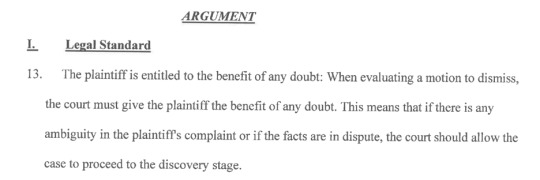
This is how the opposition begins its argument, and it’s…weird. The basic principle is...mostly correct here, but the actual standard is that when reviewing a motion to dismiss for failure to state a claim (which is what the defendant filed) the court must draw all reasonable factual inferences in the plaintiff’s favor. But even then, you don’t just put that standard in your opposition. You cite to a case that lays out the standard.
Because that’s how courts and the law work. The courts don’t operate just based on vibes. They follow statutory law (laws made by legislature) and case law (the decisions made by courts interpreting what those laws mean). You don't just submit a filing saying, "here's what the law is," without citing some authority to demonstrate that the law is what you say (or are arguing) it is.
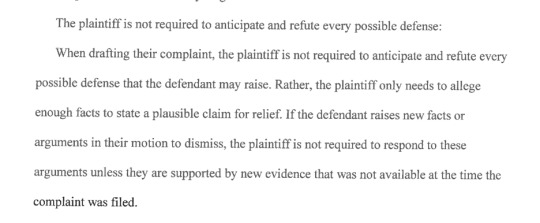
Again, this isn’t wrong (although I'm not sure what it means by new arguments?), but it’s weird! And part of the reason it’s weird is that it is irrelevant to the defendant’s motion to dismiss. The defendant filed a motion stating that based on the facts in the complaint, the plaintiff has not stated a claim based on which relief can be granted, because the complaint is time barred by a treaty. There is no reason for this language to be in the opposition. It’s almost like they just asked a chatbot what the legal standards are for a motion to dismiss for a failure to state a claim, and just copied the answer into their brief without bother to double-check it.
The opposition then cites a bunch of cases which it claims support its position. We will skip them for now, as the defendant will respond to those citations in its reply brief.
The last thing in the brief is the signature of the lawyer who submitted the brief affirming that everything in the brief is true and correct. An extremely normal - required, even! - thing to do. This will surely not cause any problems for him later.

The next relevant filing is the defendant’s reply brief. Again, the existence of a reply brief in response to an opposition is extremely normal. The contents of this brief are…less so.

Beg pardon?
Just to be clear, this is not normal. It is normal to argue that the plaintiff’s cases are not relevant, or they aren’t applicable to this case, or you disagree with the interpretations, or whatever. It is not normal for the cases to appear to not exist.
Some highlights from the brief:
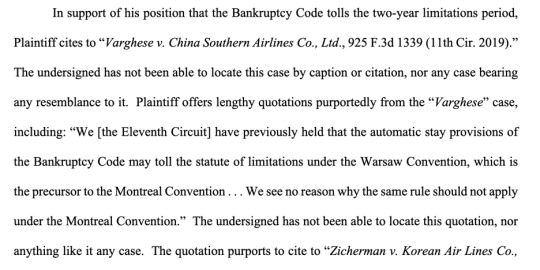

Quick lesson in how to read U.S. case citations! The italicized (or underlined) part at the beginning is the name of the case. If it is a trial court case, the plaintiff is listed first and the defendant second; if the case has been appealed, the person who lost at the lower court level (the petitioner/appellant) will be listed first, and the person who won at the lower level (the respondent/appellee) will be listed second. There are extremely specific rules about which words in these names are abbreviated, and how they are abbreviated. Next, you list the volume number and name of the reporter (the place where the case is published), again abbreviated according to very specific rules, then the page number that the case starts on. If you are citing a case for a specific quote or proposition, you then put a comma after the beginning page number, and list the page number(s) on which the quote or language you are relying on is located (this is called a “pincite”). Finally, you put in parenthesis the name of the court (if needed)(and again, abbreviated according to extremely specific rules) and the year the case was decided.
So the plaintiff’s response cited to Zicherman, which they said was a case from 2008 that was decided by the 11th Circuit Court of Appeals. However, the defendant was not able to find such a case. They were able to find a case with the same name (the same petitioner and respondent), but that case was decided by the U.S. Supreme Court in 1996, and the lower court cases associated with that case weren’t in the 11th circuit either. (The United States Reports is the only official reporter for the U.S. Supreme Court, and only includes SCOTUS decisions, so it’s not necessary to include the name of the court before the year it was decided.)
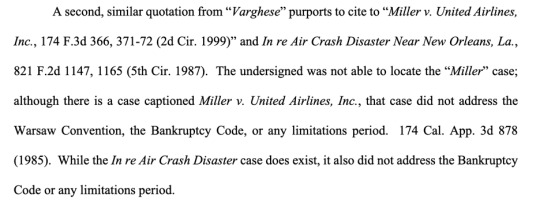
Just to be clear. The defendant’s brief is saying: the plaintiff cited and extensively quoted from these cases, and neither the cases nor the quotations appear to exist. These “cases” were not ancillary citations in the plaintiff’s brief. They were the authority it relied upon to make its arguments.
This is as close a lawyer can come, at this point in the proceedings, to saying, “opposing counsel made up a bunch of fake cases to lie to the court and pretend the law is something different than it is.”


That, “Putting aside that here is no page 598 in Kaiser Steel,” is delightfully petty lawyer speak for, “you are wrong on every possible thing there is to be wrong about.”
By page 5, the defendant has resorted to just listing all of the (apparently) made up cases in a footnote:


(skipping the citations to support this proposition)

This is where I return to my struggle to explain the opposition’s second reason why the motion to dismiss should not be granted. I struggled to explain the argument, because they failed to explain why the argument they were making (that plaintiffs can bring lawsuits against airlines in state court, and the state court have specific statutes of limitations for general negligence claims) was relevant to the question of whether the plaintiff’s specific claim against the airline was time barred by the treaty. Because 1) this case is in federal court, not state court, and 2) federal law - including treaties - preempts state law. Again, it’s almost like plaintiff’s attorney just typed a question about the time bar into a chatbot or something, and the machine, which wasn’t able to reason or actually analyze the issues, saw a question about the time to bring a lawsuit and just wrote up an answer about the statute of limitations.
We also end with a nice little lawyerly version of “you fucked up and we are going to destroy you.” The relief requested in the defendant’s original motion to dismiss was:

In their reply to the opposition, however:

“The circumstances” in this case, being the apparent fabrication of entire cases. Because courts tend to take that pretty seriously.
And the court took it seriously indeed. The defendant’s reply was docketed on March 15th of this year. On April 11th:

AKA: you have one week (an extremely prompt time frame for federal court) to prove to me that you didn’t just make up these cases.
On April 12th, the plaintiff’s attorney requests more time because he’s on vacation:

The judge grants the motion, but adds in another case that he forgot to include in his first order.
On April 25th, the plaintiff’s attorney files the following:

(And he lists the cases, with one exception, which he says is an unpublished decision.)
But he says of all of the cases except two, that the opinions…

Which is…nonsense?
First of all: if you cited a case, you had to get it from somewhere. Even unpublished opinions, if you are citing them in a brief, you are citing them because you pulled them off of westlaw or whatever. Which means you have access to the case and can annex it for the court. (There are even formal rules for how you cite unpublished opinions! And those rules include citing to where you pulled the damn case from!)
Secondly: remember that long digression I went into about how to read case citations? Remember that bit about how you include the name of the reporter (the place the case was published)? Yes, cases are published. They are printed in physical books, and they are published online in databases (e.g. lexis or westlaw). If the specific online database you are looking in does not have the case, you look somewhere else. If you have a judge telling you to get them a copy of the case Or Else, you track down a physical copy of the reporter if you need to and scan the damn thing yourself. You - literally - can’t just not have a copy of the case! (Especially published federal circuit court opinions, which multiple of these cases are! Those aren’t hard to find!)
And what kind of “online database” doesn’t include the entire opinion anyway? I’ve literally never heard of a case research database that only included partial opinions, because that wouldn’t be useful.
Maybe if we look at the attached annexed copies of the cases, that might give us some answers.
...
My friends, these things are just bizarre. With two exceptions, they aren’t submitted in any sort of conventional format. Even if you’ve never seen a legal opinion before, I think you can see the difference if you just glance through the filings. They are located at Docket entry #29 on Court Listener (April 25, 2023). Compare Attachments 6 and 8 (the real cases submitted in conventional format) to the other cases. Turning to the contents of the cases:
In the first one, the factual background is that a passenger sued an airline, then the airline filed a motion to dismiss (on grounds unrelated to the treaty's time bar), then the airline went into bankruptcy, then the airline won the motion to dismiss, then the passenger appealed. And the court is now considering that appeal. But then the opinion starts talking about how the passenger was in arbitration, and it seems to be treating the passenger like he is the one who filed for bankruptcy? It’s hallucinatory, even before you get to the legal arguments. The “Court of Appeals” is making a ruling overruling the district court’s dismissal based on the time bar, but according to the factual background, the case wasn’t dismissed based on the time bar, but on entirely other grounds? Was there some other proceeding where the claim was dismissed as time barred, and it’s just not mentioned in the factual background? How? Why? What is happening? Also it says Congress enacted the treaty? But, no? That’s…that’s not how treaties work? I mean, Congress did ratify the treaty? But they didn’t unilaterally make it!
In the second case, there’s an extended discussion of which treaty applies to the appellants claims, which is bizarre because there are two relevant treaties, and one replaced the other before the conduct at issue, so only the new treaty applies? There isn’t any discussion of the issue beyond that basic principle, so there is no reason there should be multiple paragraphs in the opinion explaining it over and over? Also, it keeps referring to the appellant as the plaintiff, for some reason? And it includes this absolutely hallucinatory sentence:

…the only part this that makes sense is that the argument is without merit. I’m not going to discuss the actual merits of the legal arguments in the opinion, because they are so bizarre and disjointed that even trying to describe them would require a Pepe Silvia-sized conspiracy board. Like the previous case, both the facts and the legal posture of the case change constantly, with seemingly no rhyme or reason.
The third one…oh boy. First, large portions of the “opinion” are individual paragraphs with quotations around the whole paragraph. What’s happening there? As far as the content of the opinion itself - I can’t. I mean that, I literally can’t. What is being discussed seems to change from paragraph to paragraph, much of it contradicting. It makes the first case seem linear and rational by comparison. The court finds it doesn’t have personal jurisdiction over the defendant so dismisses the case based on a lack of subject matter jurisdiction? But also the defendant hasn’t contested jurisdiction? And also the court does hold that it has both subject matter and personal jurisdiction over the defendant? And then it denies the motion to dismiss the case? Also, at one point it cites itself?
…also, even if this was a real case, it doesn’t stand for the propositions the plaintiff cited it for in their opposition? I’m not going to go into the weeds (honestly it’s so hallucinatory I’m not sure I could if I tried), but, for example, the plaintiff’s reply brief states that the court held “that the plaintiff was not required to bring their claim in federal court.” The U.S. District Court for the District of Columbia is a federal court, and there is no discussion of any filings in state courts. The closest the “opinion” comes is with the statement, “Therefore, Petersen’s argument that the state courts of Washington have concurrent jurisdiction is unavailing.” (This statement appears to be completely disconnected from anything before or after it, so I am unsure what it is supposed to mean.)
Moving on, case number four is allegedly a decision by the Court of Appeals of Texas. It includes the following line:

Honestly, the plaintiff’s attorney best defense at this point is that he wasn’t intentionally trying to mislead the court, because if he was doing this on purpose, he would have edited the cases to make them slightly more believable. (Context in case you’ve lost track: these documents are supposed to be copies of the opinions he is citing. The screenshoted line makes it clear that what he is actually citing is, at best, someone else’s summary of an "opinion". It would be like if a teacher asked a student to photocopy a chapter of a book and bring it into class, and instead the student brought in a copy of the cliffs notes summary of that chapter. Except that the book doesn’t even exist.)
The actual contents of the “opinion” are, as is now standard, absolutely bonkers. First, the court decides that it doesn’t have personal jurisdiction over Delta because “Delta did not purposefully avail itself of the benefits of conducting business in Texas.” This was despite the fact that the factual background already included that the appellant (sorry, the plaintiff, according to the “opinion”) flew on a Delta flight originating in Texas. Like, this is just wrong? It’s not even hallucinatory nonsense, it’s just facially incorrect legal analysis. Then the court starts discussing the treaty’s time bar, for some reason? Then it goes back to talking about personal jurisdiction, but now the trial court denied the defendant’s motion to dismiss for lack of personal jurisdiction, and the appellate court agrees with the trial court that it does have personal jurisdiction, even though this is the plaintiff’s appeal from the dismissal for lack of personal jurisdiction and the court already ruled it didn’t have personal jurisdiction? And even though on page 1, the plaintiff was injured during a flight from Texas to California, now on page 7 she was injured on a flight from Shanghai to Texas? Also the trial court has gone back in time (again) to grant the motion to dismiss that it previously denied?
Also, I’ve been trying to avoid pointing out the wonky text of these submissions, but:

Everything ok there?
Case number five is similar enough to number four that it’s not worth repeating myself.
Thank god, cases six and eight, as noted above, are real cases, so I’m going to skip them. The defendant alleges that the cases do not stand for the propositions the plaintiff cited them for, and I’m going to assume that is true, given the rest of this nonsense.
Case number seven looks legitimate on the surface. But neither the defendant nor I could find the case through any legitimate search mechanisms. The defendant looked up the purported docket numbers on PACER and found completely different cases; I was able to find a case with the name “Miller v. United Airlines, Inc.,” but it was for a different Ms. Miller, it was a California state case (not a Second Circuit federal case), it was decided on a different year, and the substance of the case was entirely different from the alleged opinion filed with the court.
On top of that, this might be the most morally reprehensible fake citation of them all? Because it is about the crash of United Airlines Flight 585, a real plane crash. Everyone on board - 25 people in total - was killed.
The individual cited in this fake court case was not one of them.
I cannot imagine conducting myself in such a way where I would have to explain to a judge that I made up a fake case exploiting a real tragedy because I couldn’t be bothered to do actual legal research.
Now, I know you all have figured out what’s going on by now. And I want you to know that if your instincts are saying, “it seems like the lawyer should have just fallen on his sword and confessed that he relied on ChatGPT to write his original brief, rather than digging himself further into this hole”? Your instincts are absolutely correct.
Because obviously, the court was having none of this b.s. On May 4th, the court issued an order, beginning with the following sentence:

That is one of the worst possible opening sentences you can see in an order by the court in a situation like this. The only thing worse is when judges start quoting classic literature. If I was Mr. Peter LoDuca, counsel for the plaintiff, I would already be shitting my pants.
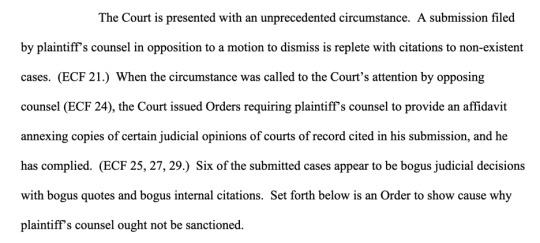
“I gave you an opportunity to either clear things up or come clean. Now I’m going to give you an opportunity to show why I should only come down on you like a pile of brinks, instead of a whole building.”

We are getting dangerously close to “quoting classic lit” territory here.
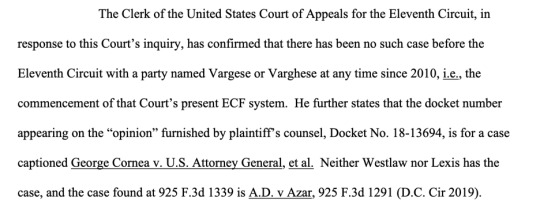
If I learned that the judge in my case called up the clerk of a circuit court just to confirm how full of shit I was, I would leave the legal profession forever. Also, the judge is now also putting quotes around “opinion.” When judges start getting openly sarcastic in their briefs, that means very very bad things are about to happen to someone.

So I’m guessing the delay between this filing and the court order was because the judge’s clerk was tasked with running down every single one of the additional fake citations included in the "opinions", just to make this sure this order (and the upcoming pile of bricks) are as thorough as possible.
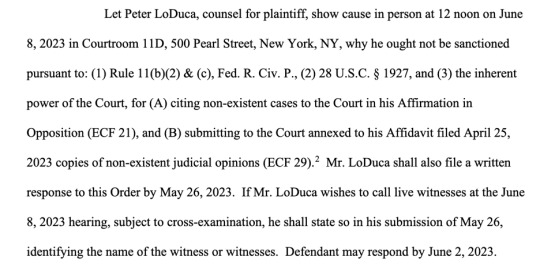
If you are following along with Dracula Daily, the vibe here is roughly the same as the May 19th entry where Dracula demands Jonathan Harker write and pre-date letters stating he has left the castle and is on the way home.
Also, hey, what’s that footnote?

Wait, what?
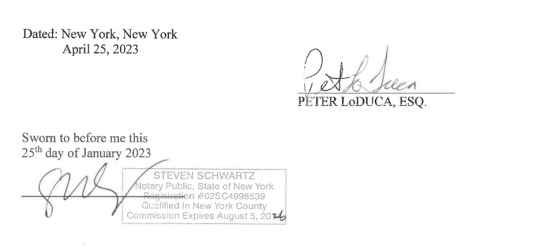
Folks, it appears we may have notary fraud, on top of everything else! Anybody have bingo?
So on May 25, one day before the deadline, Mr. LoDuca filed his response. And oh boy, I hope ya’ll are ready for this.
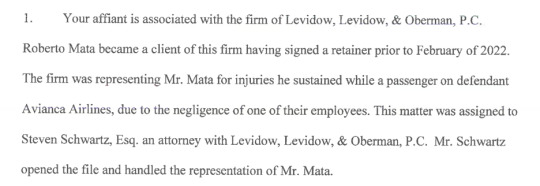
Hey, what’s the name of that other attorney, “Steven Schwartz”? Where have I seen that name before…
...I ran out of room for images on this post. So I'm going to have to leave this as an accidental cliffhanger. Part 2 to follow once I refresh my tea.
9K notes
·
View notes
Text
Verse 12.18 & 12.19 - Bhakti Yoga
समः शत्रौ च मित्रे च तथा मानापमानयोः ।शीतोष्णसुखदुःखेषु समः सङ्गविवर्जितः ॥१२-१८॥
तुल्यनिन्दास्तुतिर्मौनी सन्तुष्टो येन केनचित् । अनिकेतः स्थिरमतिर्भक्तिमान्मे प्रियो नरः ॥ १२-१९॥
He who is the same to foe and friend, and also in honor and dishonor; Who is the same in cold and heat, and in pleasure and pain, who is free from attachment. (18)
To whom censure and praise are equal, who is silent, content with anything, homeless, steady-minded, full of devotion — that man is dear to Me. (19)
The devotee of the Supreme Lord should be impartial to all living beings, and not be affected by the dualities of the material world. He should remain equipoised in all situations, whether favorable or unfavorable, and not be attached to anything that is temporary and illusory. He should be detached from the bodily conception of life, and identify himself as the Eternal soul, part and parcel of the Lord. Such a devotee is very dear to the Lord, and attains His supreme abode.
The devotee who is indifferent to both censure and praise from others does not depend on external validation for his self-worth. He is humble and does not seek fame or recognition.
The devotee who is silent does not engage in idle talk or gossip. He is mindful of his speech and uses it for the benefit of others. He also practices silent contemplation on the Self and the Supreme Lord.
The devotee who is content with anything is free from attachment and desire. He accepts whatever comes his way as the grace of God and does not complain or hanker for more. He is satisfied with the bare necessities of life and does not crave for luxuries or comforts.
The devotee who is homeless does not identify with any particular place or situation. He is not attached to his body, family, possessions, or status. He is a wanderer in this world, knowing that his true home is in God.
The devotee who is steady-minded is not disturbed by the dualities of life, such as heat and cold, joy and sorrow, gain and loss. He remains calm and composed in all circumstances, keeping his mind fixed on God.
The devotee who is full of devotion is constantly engaged in the service and worship of God. He loves God with all his heart, soul, mind, and strength. He surrenders his will to God and follows His commands.
Such a devotee is very dear to the Lord, because he has attained the highest state of bhakti, or pure love for God. He is a perfect example of a nishkama bhakta, or a selfless devotee, who does not ask for anything from God except His love.
Similar verses from Vedic texts are:
- In the Yajur Veda (40.8), it is said:
सर्वं खल्विदं ब्रह्म तज्जलानिति शान्त उपासीत । अथ खलु क्रतुमयः पुरुषो यथाक्रतुरस्मिँल्लोके पुरुषो भवति तथेतः प्रेत्य भवति स क्रतुं कुर्वीत ॥
All this is verily Brahman. From Him do all things originate, into Him do they dissolve and by Him are they sustained. On Him should one meditate in tranquility. For as is one's faith in this world, such one becomes on departing hence. Let one, therefore, cultivate faith.
This verse declares the oneness of Brahman, the Absolute Reality, and the origin, sustenance and dissolution of all phenomena in Him. It also instructs one to meditate on Brahman with a calm mind, and to cultivate faith in Him, as one's destiny is determined by one's thoughts and actions in this life.
- In the Yogavashishta (6.2.178), it is said:
अविद्याकृतबन्धानां विद्याकृतविमोचनम् ।विद्याविद्यात्मकं ब्रह्म विद्याविद्याविवर्जितम् ॥
Ignorance causes bondage, knowledge causes liberation. Brahman is both knowledge and ignorance, yet Brahman is beyond both knowledge and ignorance.
This verse explains the role of ignorance (avidya) and knowledge (vidya) in the bondage and liberation of the soul. Ignorance is the cause of identifying oneself with the body and the mind, and suffering the miseries of birth and death. Knowledge is the means of realizing one's true nature as Brahman, and attaining freedom from the cycle of samsara. Brahman is the source of both ignorance and knowledge, as He manifests Himself in various forms through His inscrutable power of maya. Yet Brahman is also transcendent, and unaffected by either ignorance or knowledge. He is the supreme reality, beyond all dualities and limitations.
- From Mundaka Upanishad:
य एवं वेद हितं त्यजति बहुनां साम्राज्यलक्ष्मीम् । स ब्रह्मणा सह मोदते तस्य तृप्तोऽश्नुते न कामकामी ॥
He who knows this, renounces here the merit of many a realm, He rejoices with Brahman, contented he enjoys, he is not a desirer of desires.
This verse states that the knower of Brahman, the Supreme Reality, renounces all worldly pleasures and rewards, even the sovereignty of many worlds. He is happy and contented with Brahman alone, and does not seek anything else. He is free from all desires, because he has attained the highest fulfillment.
1 note
·
View note
Text
Twitter's Censure of Donald Trump: Navigating Free Speech and Democracy in the Digital Age
In today's digital world, where social media platforms significantly influence political discourse, Twitter's decision to censure former President Donald Trump brings critical questions about free speech and democracy to the forefront. This blog post explores whether Twitter's actions were an infringement of free speech principles or a necessary step within democratic values.

The Escalating Conflict Between Trump and Social Media
President Trump has openly accused Twitter of infringing on his free speech. This accusation came after Twitter fact-checked his tweet about mail balloting and later restricted the visibility of another tweet related to the Minneapolis protests. Trump's long-standing tension with Silicon Valley tech giants escalated, culminating in a complex legal battle and concerns over the future of online free expression. The situation heated up when Twitter took action against his tweet for glorifying violence, prompting Trump to vow retaliation against the platform (Phillips 2020) (Romm & Timberg 2020).
Debunking Trump's Free Speech Violation Claims
However, Trump's claims of a constitutional free speech violation by Twitter don't hold up for two primary reasons:
Twitter's Status as a Private Company: The First Amendment protects against government censorship, not actions by private entities like Twitter. As a private platform, Twitter has the right to manage its content, including tweets from the president, under its own policies. This content management autonomy is safeguarded by the First Amendment (Phillips 2020).
Platform's Right to Content Regulation: Twitter can regulate its content as it sees fit, in line with its terms of service. If dissatisfied, users, including President Trump, can migrate to other platforms (Phillips 2020).

Trump's Countermeasures and Their Implications
The issue's complexity escalated when Trump signed an executive order to increase federal oversight of social media companies' content moderation practices. This legally questionable order suggests social media companies are exceeding legal boundaries in content regulation despite laws protecting them from liability. It has been criticized for potentially inviting government interference in private businesses, raising First Amendment concerns (Phillips 2020).
Silicon Valley in the Political Crosshairs
Trump's actions, perceived as a strategy to energize his base, exploit the tech industry's vulnerabilities, such as past failures in handling disinformation and privacy issues. This strategy has led to declining public trust in the tech sector, particularly among Republicans. It frames Silicon Valley as an electoral adversary(Romm & Timberg 2020).
Case Studies from Southeast Asia
Reflecting the global impact of social media in politics, various case studies from Southeast Asia highlight its influence:
Cambodia: Prime Minister Hun Sen's strategic use of social media during elections, including deleting his Facebook account to avoid suspension and shifting to platforms like Telegram and TikTok (Fitriani & Habib 2023).
Thailand: The Move Forward Party's general election success is partly attributed to leader Pita Limjaroenrat's effective use of Instagram (Fitriani & Habib 2023).
Indonesia: Expected trends in the upcoming presidential election include using political bots and buzzers, reflecting the adaptation to a young, tech-savvy demographic (Fitriani & Habib 2023).
Malaysia: The Parti Islam se-Malaysia (PAS) leveraged TikTok in its campaign strategy, significantly contributing to its general election success (Fitriani & Habib 2023).
Myanmar: The National Unity Government's (NUG) use of social media for public communication and awareness amidst criticisms of propaganda and misinformation (Fitriani & Habib 2023).
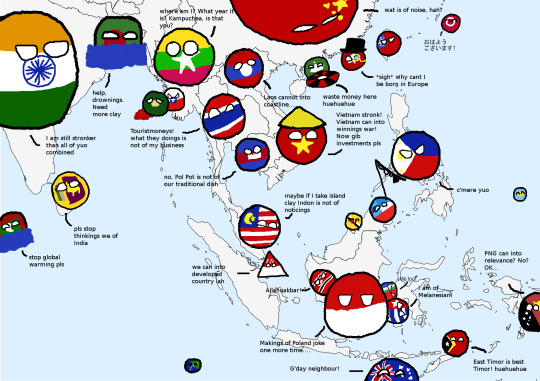
The Dilemma for Tech Companies
Tech companies now face the challenge of moderating content while fending off allegations of political bias. Trump's focus on alleged discrimination is part of his broader strategy to address perceived censorship, such as hosting a White House summit. The recent executive order could bring about significant changes in the digital landscape and raise questions about the government's role in regulating online speech (Romm & Timberg 2020).
Social Media's Role in Politics and Its Double-Edged Sword
Social media's importance in politics is underscored in Southeast Asia, where platforms are used extensively for political campaigns. While social media expands the reach of politicians beyond traditional media and allows for tailored messaging, it also raises issues like echo chambers, political polarization, and the spread of misinformation (Fitriani & Habib 2023).
Mitigating the Risks of Social Media in Politics
To counter these risks, educating the public about online misinformation is vital. Encouraging social media companies to actively remove false content and promote transparency in moderation policies is crucial for maintaining social media's integrity as a tool for democratic engagement (Fitriani & Habib 2023).
Conclusion
In conclusion, Twitter's censure of Donald Trump opens up a broader discussion about the responsibilities of social media platforms in public discourse. As we navigate these complex issues, the balance between protecting free speech and maintaining democratic values in the digital realm remains a topic of vital importance.
References
Fitriani, & Habib, M. (2023, August 10). Social Media and the fight for political influence in Southeast Asia. The Diplomat. https://thediplomat.com/2023/08/social-media-and-the-fight-for-political-influence-in-southeast-asia/
Phillips, A. (2020, May 29). Analysis | no, Twitter is not violating Trump’s freedom of speech. The Washington Post. https://www.washingtonpost.com/politics/2020/05/29/no-twitter-did-not-violate-trumps-freedom-speech/
Romm, T., & Timberg, C. (2020, May 29). Trump’s growing feud with Twitter fuels free-speech concerns. The Washington Post. https://www.washingtonpost.com/technology/2020/05/29/words-president-matter-trumps-growing-twitter-feud-fuels-free-speech-concerns/
1 note
·
View note
Text
0 notes
Photo
On est inondé de bots
cestdanslateteS'abonner
Les bots, ça nous fait tous chier sur Tumblr (je viens d'en bloquer 6 à l'instant). Mais, au-delà de ça, ce qui m'emmerde est de constater que l'ensemble de ces comptes consistent en des faux profils de nanas, la plupart du temps quasi-dénudées, parce que c'est ça qui fait vendre, qui génère du clic.
jesuisunoiseaulibre
Idem
cellobis
"Ce Tumblr est super, mais il est vide", merci on s'en doutait. Même pas la peine, mais ces bots, robots amputés, nous emmerdent par leur laideur. Ces jarretelles et autres accessoires inutiles ne m'ont jamais fait bander et me révulsent : je suis bien plus ému par la pureté de la nudité comme par celle d'une larme. Comment bloquer ça définitivement sur Tumblr? qui est pourtant foutu de censurer le beau, l'épuré parfait lequel nous colle à la peau depuis la nudité de notre naissance en ce monde.

532 notes
·
View notes
Text
Telegram Creator on Elon Musk, Resisting FBI Attacks, and Getting Mugged...
youtube
Pavel Durov e a Indústria Global WOKE da CENSURA.
Por: Fred Borges
O propósito da censura está na manutenção do status quo, evitando alterações de pensamento num determinado grupo social e a consequente disposição de mudança de paradigmas políticos ou de comportamento. Desta forma, a censura é muito comum entre alguns centros de influência, como certos grupos de interesses (lobbies), instituições religiosas e governos, como forma de fazer a manutenção do poder ou constituir hegemonia. A censura procura também evitar que certos conflitos e discussões se estabeleçam na sociedade, pelos mesmos motivos anteriormente expostos.
A crescente popularidade do Telegram atraiu a atenção de governos "populares" de todo o mundo, incluindo a França,na terceira fase da Revolução Francesa-Trocam o regime mas continuam cortando cabeças, que alegou – sem apresentar evidências – preocupações com “segurança” e a “violação de dados”.
A Rússia tentou banir o Telegram em 2018 após o criador Pavel Durov recusar a entregar mensagens dos usuários ao Kremlin. No entanto, o Telegram contornou a proibição redirecionando seu tráfego, e os reguladores russos não conseguiram bloquear o acesso. Em 2020, a proibição foi revertida, e hoje o Telegram é uma das principais ferramentas de comunicação na Rússia.
Mas não só na Rússia, afinal a hegemonia é burra assim como a unanimidade.Durov já havia relatado pressão de agências de segurança dos Estados Unidos, afirmando que o FBI e outras autoridades tentaram estabelecer "um relacionamento para melhor" controlar o Telegram.
No Brasil, o Telegram, assim como o " X" enfrentou várias tentativas de censura e banimento pelo judiciário. Em março de 2018, um ministro do Supremo Tribunal Federal (STF) ordenou o bloqueio do aplicativo em todo o território nacional, apesar da Constituição vigente vetar censura. O STF alegou que o Telegram deveria censurar três usuários por supostamente divulgar informações que não seriam verdadeiras.Ambos, sedes, saíram do Brasil, um péssimo indicador ou métrica democrática.
O Telegram, frequentemente alvo de perseguições judiciais, foi forçado a contratar representantes legais no Brasil; mas encerrou o contrato posteriormente, ficando sem representação legal no país.
Em outro caso de censura emblemático contra o Telegram, após emitir um editorial detalhando o Projeto de Lei 2630, conhecido como PL da Censura, que buscava implementar censura estatal e ameaçava a liberdade de expressão no país, o STF censurou o informativo e também determinou que a plataforma emitisse a opinião que eles achavam correta sobre um PL.
O Telegram oferece:
Canais anônimos onde as pessoas podem compartilhar informações;
Feeds de notícias;
Bots que automatizam diversas tarefas;
Recursos de criptoativos que permitem a compra e venda de bens e serviços.
Tudo copiado pelo Whatsapp e com o detalhe das contínuas vulnerabilidades técnicas ou políticas do mesmo.
O que diferencia o Telegram de muitos outros apps é o seu foco em privacidade e segurança. Ele utiliza criptografia para proteger as mensagens dos usuários e é conhecido por sua postura contra a censura. Isso o tornou popular em países onde a liberdade de expressão é limitada.
Em 2024, de acordo com a Demand Sage, o Telegram conta com aproximadamente 900 milhões de usuários ativos mensais. Isso reflete um aumento significativo em relação aos anos anteriores, destacando a crescente popularidade da plataforma. Recursos como opções aprimoradas de privacidade e sua flexibilidade em suportar mensagens multimídia, chamadas de voz e vídeo, contribuíram para seu apelo global. Ele é particularmente popular em países como Índia, Rússia, Ucrânia e Irã.Logo não podemos dizer ser esse aplicativo parcial ou " monitorado" ou manipulado por quaisquer governos.
O impacto do Telegram disparou em tempos de crise. Por exemplo, após a invasão da Ucrânia pela Rússia, os ucranianos passaram a gastar oito vezes mais tempo no Telegram do que antes. O app se tornou uma ferramenta crucial para compartilhar notícias, coordenar esforços voluntários e até mesmo avisar sobre ataques aéreos em áreas onde as sirenes não eram ouvidas.
A prisão de Durov é um evento sísmico no mundo da tecnologia e da liberdade. Ela ressalta os desafios que plataformas globais enfrentam. Privacidade, segurança e o papel da tecnologia em um mundo conectado estão agora no centro das atenções, independente das autocracias, ditaduras, democracias imperfeitas ou qualquer denominação.
Quanto à cultura woke pode levar a uma "correção política extrema" a Esquerda, cerceando a liberdade de expressão e gerando um ambiente onde o medo de transgredir normas sociais prevalece sobre a autenticidade.Um livre intercâmbio de ideias não é e nem parece interessar os Woke, para eles não há um interior humano, as pessoas não passam de uma coleção de identidades sociais, sem uma história ou um relato que as una como humanidade. O lema é dividir para governar!A ideologia Woke se apresenta como uma luta benévola por justiça, mas está longe de sê-lo, ao trocar princípios lógicos e inteligíveis ou racionais por teorias sem sustentação prática, semeando incoerência e colhendo o caos.
Milhões de usuários do Telegram enfrentam incertezas. A plataforma confiável mudará ou permanecerá a mesma? Apenas o tempo dirá. Mas uma coisa é certa. O mundo da tecnologia ou da liberdade está atento. Os governos estão em alerta prontos para matar a liberdade, travestidos de WOKE e esta história está longe de acabar,talvez a terceira fase da Revolução Francesa seja o retorno da segunda;a guilhotina ou seria a "Woketina"!?
0 notes